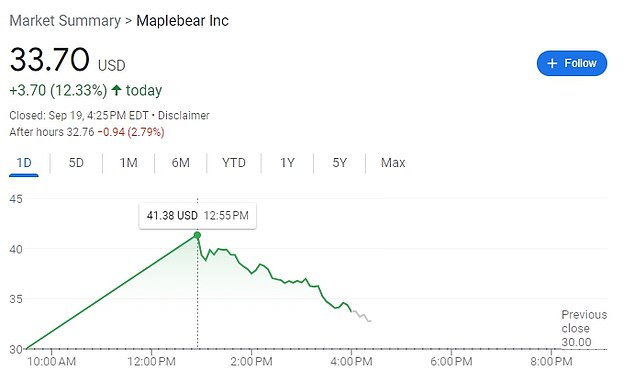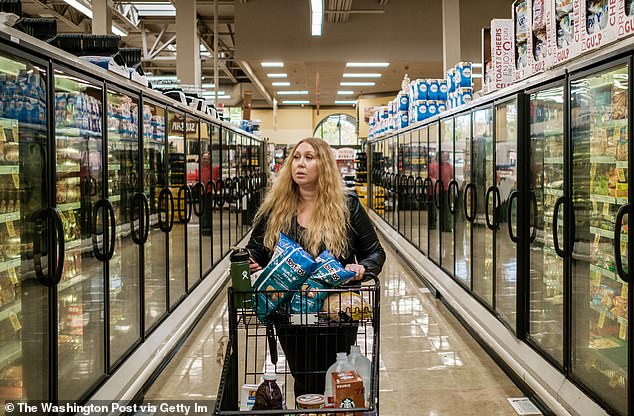Instacart stock jumps 40% in the first day of trading, giving the grocery delivery app a $14B valuation
Instacart responded to investors during its stock market debut.
Shares of the grocery delivery app soared as much as 43% when they began trading Tuesday on the Nasdaq under the symbol CART, giving the company a valuation of more than $14 billion.
At Instacart headquarters in San Francisco, CEO Fidji Simo and other executives celebrated the IPO by ringing a bell shaped like the company’s carrot logo. About 1,000 employees participated, the company said.
The public stock offering is a highly anticipated milestone for Instacart, founded in 2012, and also a sign that the long drought in the IPO market is coming to an end.
The company filed for an IPO privately in May 2022, but delayed those plans last fall when markets were in turmoil due to recession fears.
At Instacart headquarters in San Francisco, CEO Fidji Simo and other executives celebrated the IPO by ringing a bell shaped like the company’s carrot logo.

The San Francisco-based company’s IPO price was at the high end of its $28 to $30 price range and reached as high as $42.95 before ending the session at $33.70.
There were just 71 IPOs in the U.S. last year, the lowest number since 2009, according to Renaissance Capital.
However, the market is in the midst of a resurgence and we are seeing more IPO activity this year, as the Federal Reserve appears ready to pause its rate hikes and recession fears ease.
Last week, shares of British chipmaker Arm Holdings rose nearly 25 percent in their trading debut on Nasdaq, the largest IPO in nearly two years.
Joe Endoso, president of Linqto, an investment platform, said a successful listing by Instacart could prompt others, particularly technology companies, to consider IPOs in the coming months.
“Global financial markets are buzzing with optimism about a possible resurgence of the IPO market,” he said.
The company, officially known as MapleBear Inc, raised total proceeds of $660 million from the IPO, of which $237 million will be returned to investors who sold their shares in the offer.
The San Francisco-based company’s IPO was priced at the high end of its $28 to $30 price range and reached as high as $42.95 before ending the session at $33.70, a gain of 12 .3 percent.
The $30 IPO price gave Instacart an opening market value of about $10 billion, significantly lower than the $39 billion valuation it was given after a fundraising round in 2021.
Several startups have seen their valuations decline since 2022 as inflation, geopolitical tensions and rapid Fed rate hikes have altered the appetite for riskier investments.
Instacart offers delivery and pickup to 85% of U.S. grocers, or more than 80,000 stores, using a network of 600,000 independent shoppers.

Instacart shares soared as much as 43% as they began trading on the Nasdaq under the symbol CART on Tuesday.
It also provides in-store technology, such as smart carts and electronic labels, and sells online advertising to food companies and retailers.
It claims to have 7.7 million active customers who spend around $317 per month on the platform.
In a letter to investors earlier this month, he said there was huge potential in food delivery. The American food market is at $1.1. industry, but only 12 percent of sales are made online. She said she expects that figure to at least double over time.
“We have demonstrated our ability to help our business partners drive strong growth and remain competitive in a complex and increasingly digital industry,” wrote Simo, a former Facebook executive who became CEO of Instacart in 2021. Simo has grew up in France and is the daughter and granddaughter of fishermen.
The food delivery market exploded at the start of the pandemic. Growth has stabilized, but the market is still about four times larger than it was in 2019, said David Bishop, partner and principal researcher at Brick Meets Click, a consulting firm specializing in procurement. online grocery shopping.
This market is also increasingly competitive. Instacart faces growing pressure from companies like Uber Eats and DoorDash, both of which began delivering groceries in 2020.
As of August, Instacart controlled 70% of the U.S. third-party grocery delivery market, according to YipitData, a market research firm.
DoorDash controls about 10 percent. This week, DoorDash added more U.S. grocers to its offering, including Cub, Lowe’s Markets and Eataly.
Instacart also faces pressure from grocers themselves, who sometimes bristle at the higher prices Instacart charges or the pricing rules it puts in place for grocers using its software to run their own websites.
Instacart orders can cost consumers 15 to 20 percent more than in-store purchases because of delivery fees and markups on products, Bishop said.
Some grocers have severed partnerships with Instacart or developed their own delivery capabilities.
HEB, a Texas chain, encourages customers to shop on its own site, not Instacart’s, if they want lower-cost delivery, Bishop said. Other major grocers, like Walmart and Target, also do their own deliveries.

Instacart shopper Vanessa Bain shops for a customer at Safeway in Menlo Park, California
Bishop said Instacart needs to retain its customers because it relies on them to sell ads.
“It’s increasingly difficult to see how Instacart can do this as its competitors expand into the grocery business and grocers look more closely at how they can improve the profitability of online sales,” he said. he declared.
Food price inflation over the past two years has also dampened demand for delivery in favor of cheaper curbside pickup.
U.S. takeout grocery orders increased 3% to $10.5 billion between April and June of this year, compared to the same period last year, Bishop said. Grocery delivery orders rose just 1 percent to $7.8 billion.
Instacart’s orders also slowed in the first half of this year after increasing 18% between 2021 and 2022, the company said in its IPO filing.
Still, Instacart’s revenue rose 31% to $1.47 million in the first six months of this year, largely thanks to increased advertising fees collected from retailers and food companies .
The company reported net income of $242 million in the first six months of this year.
Among those optimistic about Instacart’s prospects is PepsiCo, which agreed to buy $175 million of convertible preferred stock in a private placement.
